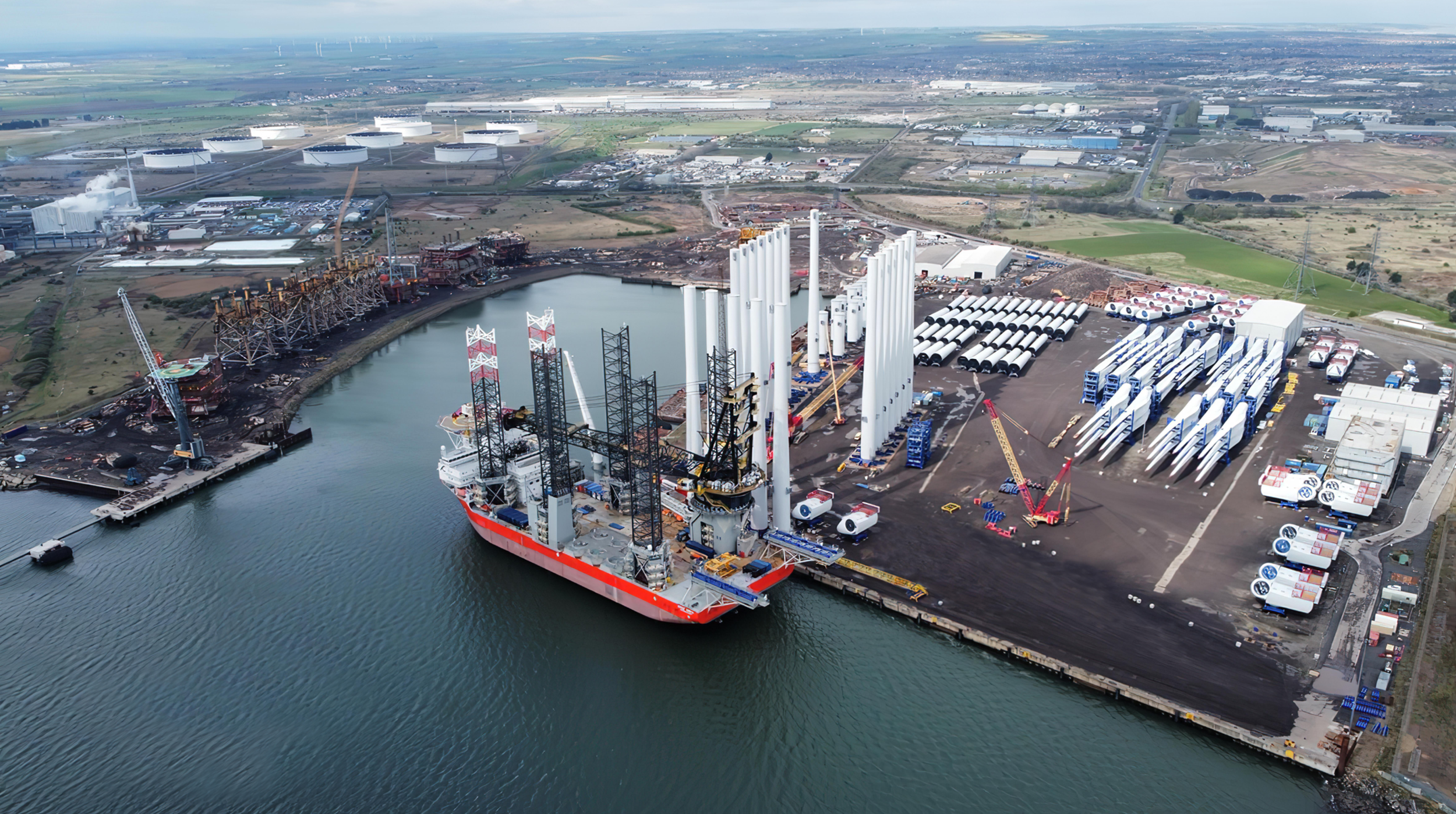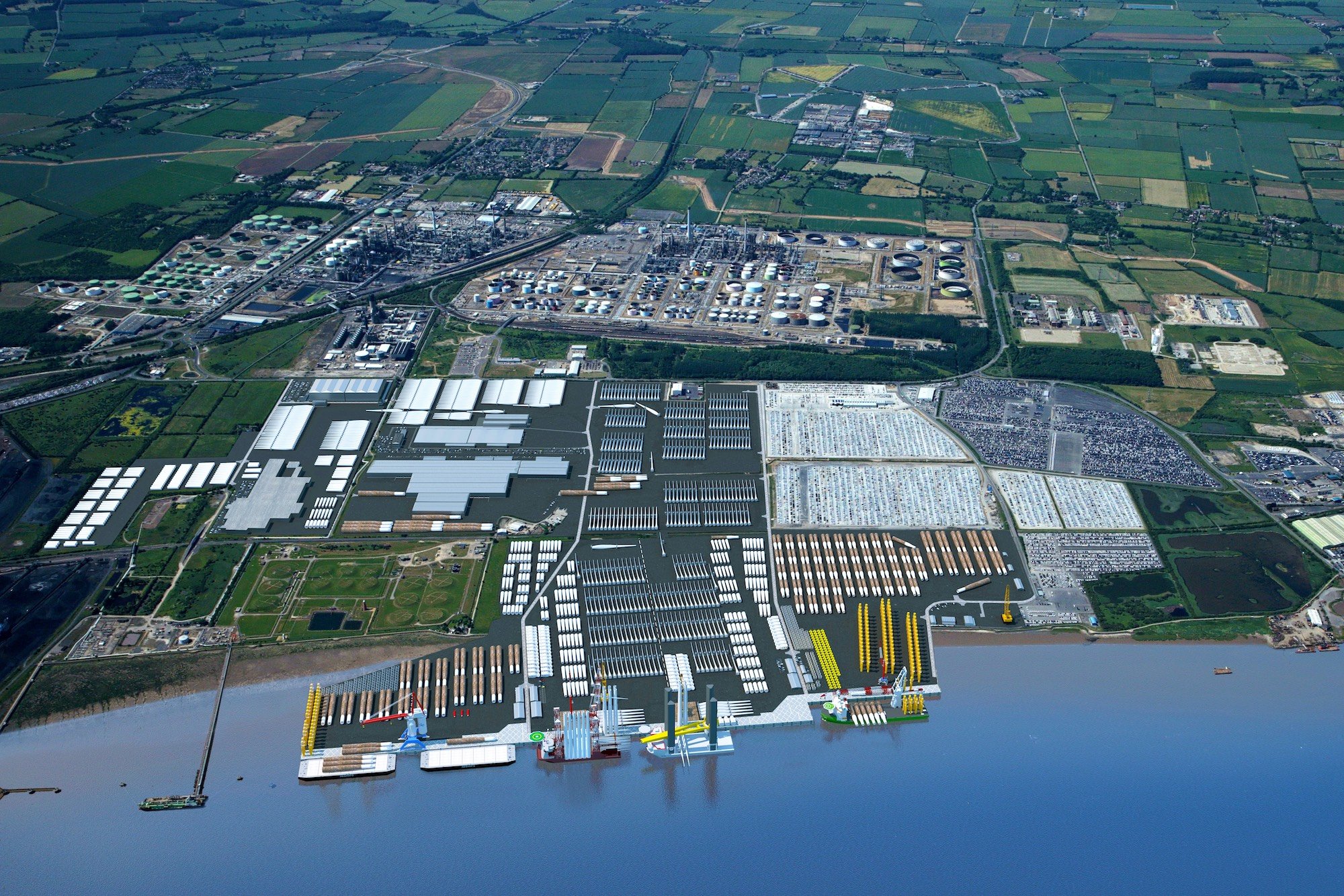
Offshore Wind
Able Seaton Port
ASP has full planning permissions for offshore wind manufacturing, pre-assembly, storage and associated activities. Existing manufacturing and warehouse buildings are available and planning permission is in place to construct new buildings, if required. In this regard, ASP provides the major benefit of being able to manufacture and deploy from the same port.
ASP is a 51 hectare (126 acre) site and has some of the strongest quays in Europe which have been constructed particularly to suit the requirements of the offshore energy sector.
ASP has the capacity to handle virtually all offshore vessels that are operating in the North Sea.
ASP has large mobile harbour and crawler cranes already available along with SPMT’s and other plant and equipment to handle offshore wind components.
ASP is a ISPS Level 3 port.
ASP was selected by GeoSea (on behalf of Ørsted) as the installation base for the foundation package for Hornsea One, in August 2018 ASP was confirmed by Triton Knoll/MHI Vestas as the installation base for the turbine package for Triton Knoll Offshore Wind Farm.
In addition in August 2023 ASP was the installation base for the Dogger Bank Wind Farm (the world’s largest offshore wind farm) to install the first of 277 GE Vernova Haliade-X 260m tall turbines – which are almost twice the height of the London Eye – and will be installed c.80 miles off the coast of Yorkshire using a specialist vessel with a lifting capacity of 3,200 tonnes, the largest of its kind in the world.
The ASP site provides an exciting option, in so far that it is a fully constructed operational port and one of the most flexible ports on the East Coast of the UK.
Able Humber Port
Able Humber Port (AHP) is a port development on the south bank of the Humber Estuary on the East Coast of the United Kingdom. It is a nationally significant infrastructure project (NSIP) and is recognised as a core development within the UK Government Infrastructure Roadmap. AHP represents a singular opportunity for the UK to establish a world-scale industrial cluster and enable the UK to maximise the economic development potential provided by the combination of the emerging market and supportive policies.
AHP can assist the Offshore Wind Industry by providing the following services:
Operational hub/marshalling harbour for the construction of UK and potentially European, offshore wind projects;
Port location for the establishment of meaningful supply chain activity and component manufacture.
AHP provides a strong and sustainable proposition to offshore wind farm developers and manufacturing partners within the supply chain.
AHP’s core objective is to provide a more efficient UK port facility particularly to enable the offshore renewables sector to reduce its costs and maximise efficiency and profitability.
The confirmation of the major offshore wind players, as AHP tenants will provide a significant enhancement to the regions economy and endorse the Humber as the cornerstone for the enlargement of an international scale offshore wind cluster in the UK.
AHP ultimately provides the sector with a greater opportunity to reduce its overall costs (lowering the overall costs of the delivered component) and provides very significant benefits to the local and UK economy in terms of job creation and export potential.
Hornsea One Offshore Wind Farm
One of Able’s port facilities on the River Tees - Able Seaton Port (ASP) provided the installation base for the foundation package for Ørsted’s 168 OWT, 1,200MW Hornsea One offshore wind farm.
The contract extended over an intensive 13-month period and was completed at the end of January 2019. Able provided both the facility and the onshore logistics and the project was completed without incident and, critically without any Lost Time Incidents – reflecting the strong and collective partnership working of all parties.
It included the safe transportation, using ABLE’s own fleet of SPMTs handling 550 components and supporting accessories which included:
Monopiles – the heaviest at 993 tonnes and the longest at 71 meters.
Transition Pieces – 28m tall weighing c. 360 tonnes;
Anode Cages etc.
There were 107 Transition Pieces - manufactured on the Tees, by Offshore Structures Britain (OSB) and Wilton Engineering - that were delivered and transferred direct from a barge on to the collecting installation vessel at ASP.
All the Monopiles were sourced from EEW’s Rostock facility in Germany and the balance of the Transition Pieces from Bladt Industries based in Aaborg, Denmark. The deliveries were made by SAL’s 15,000 tonne ship the MV Svenja.
The installation programme was led by the vessel the GeoSea Innovation which was able to jack-up adjacent to the quay at ASP and utilise its c. 1,500 tonne crane capacity. It was assisted by two of her sister ships – the Sea Installer and the Sea Challenger – which installed most
of the Transition Pieces.
The project set potentially new standards in productivity, most notably the safe load-out of four monopiles within a three-hour period.
Triton Knoll Offshore Wind Farm
From September 2020 ABLE provided the installation base for the turbine package for RWE’s 860MW Triton Knoll offshore wind farm with Vestas Offshore Wind as the actual occupier. It involved the deployment of 90 turbines, the assembly of 3 tower sections per turbine and the marshalling of 270 turbine blades.
GeoSea/DEME provided the offshore installation vessels.
ABLE has pioneered, as evidenced by both the Hornsea One and Triton Knoll projects, an innovative business model that meets the needs of the offshore wind sector. To this end ABLE provides fixed lump sum prices for the use of the facility AND the provision of the onshore logistics required by the project.
This includes, as necessary, the unloading of vessels, the movement of components to storage, the provision of load grillage for the storage of equipment, the ‘picking’ of components and the assembly and movement of products back to the quayside for loading/collection.
Dogger Bank Offshore Wind Farm
Able Seaton Port is the marshalling base for Dogger Bank Wind Farm, the largest wind farm in the world, utilising GE’s 13/14MW Haliade-X as the turbine powering the 3 phases of the project. This has enabled the creation of 120 new skilled jobs during the construction phase.
The campaign to install the first of 277 turbines at the world’s largest offshore wind farm is now underway, marking a major advance in the industry and speeding up the transition to a cleaner, more secure energy system.
The 260m tall turbines – which are almost twice the height of the London Eye – will be installed c.80 miles off the coast of Yorkshire using a specialist vessel with a lifting capacity of 3,200 tonnes, the largest of its kind in the world.
GE Renewable Energy established its marshaling harbour activities at ASP in November 2022 which served as the base for turbine service equipment, installation and commissioning activities for Dogger Bank A, B and C. This sees the delivery of component parts for each of GE’s Haliade-X 13/14MW wind turbines to our specialist port, including the nacelle, three tower sections and three 107m long blades, for pre-assembly on-site at ASP prior to transport out to the North Sea for installation.
The contract represents the largest single order ever for offshore wind turbines, confirming 277 turbines for Dogger Bank A, B and C installed off the north-east coast of England in 3 phases.
The scale of Dogger Bank Wind Farm is immense, occupying an area almost as large as Greater London, on seabed that once formed a land bridge between the UK and Europe. When fully complete it will have an installed capacity of 3.6GW of renewable electricity – more than two and a half times the size of the next largest offshore wind farm – and be capable of producing enough clean energy to power the equivalent of 6 million homes annually.
At 260m, the turbine is almost twice the height of the London Eye and equivalent in height to the iconic Rockefeller Centre in New York.
Each turn of its 107m wide blades will produce enough clean energy to power an average UK home for 2 days.
Once fully operational, Dogger Bank will generate annual CO2 savings equivalent to the emissions of nearly 1.5 million average internal combustion engine petrol cars.
The installation vessel, Jan de Nul’s Voltaire, is the largest offshore jack-up installation vessel ever built and is the first ultra-low emission ship of its kind.














